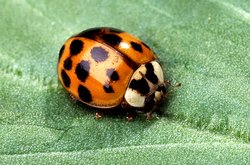Asian Lady Beetle
|
|
| Asian Lady Beetle | ||||||||||||||
|---|---|---|---|---|---|---|---|---|---|---|---|---|---|---|
 | ||||||||||||||
| Scientific classification | ||||||||||||||
| ||||||||||||||
| Binomial name | ||||||||||||||
| Harmonia axyridis |
The Asian lady beetle (Harmonia axyridis), often known as the Asian multicolored lady beetle because of the species' tendency to vary in color from orange to yellow to even black, is now a common insect in North America. It is a non-native insect on the continent, introduced in the United States in an attempt to control the spread of aphids. After many years of trying to establish a North American population of these beetles brought from their native region in northeastern Asia, a group finally took root in Louisiana around 1988. Since then, the insect has spread throughout the United States and has succeeded in controlling aphid populations. However, many people are now coming to view the Asian lady beetle as a nuisance, probably partly due to the fact that they not only like to overwinter indoors, along with the fact that they emit an unpleasant odor and a defensive stain when squashed.
In the U.S., the first attempts to introduce the beetle took place as far back as 1916. Repeated efforts were not very successful. In the early 1980s, aphids were causing significant problems for growers of pecan trees, so the United States Department of Agriculture again attempted to bring the insect into the country—this time in the southeastern United States. After a period of time, USDA scientists concluded that their attempts had been unsuccessful. However, a population of beetles was soon observed near New Orleans, Louisiana. In the following years, the beetle quickly spread to other states, being occasionally observed in the Midwest within about 5–7 years, and becoming common in the region by about 2000.
Asian lady beetles hibernate in cooler months, though they will wake up and move around whenever the temperature reaches about 50°F (10°C). Because the beetles will use crevices and other cool, dry, confined spaces to hibernate, significant numbers may congregate inside walls if given a large enough opening. They often congregate in sunlit areas because of the heat available, so even on fairly cold winter days, some of the hibernating beetles will “wake up” because of solar heating. These large populations can be problematic because they can form swarms and hover in an area for a long time. Also, the bugs do not understand that glass cannot be penetrated by their small bodies, so many of the bugs will crash into window panes.
These bugs will “reflex bleed” when agitated, releasing blood from their legs. The blood has a foul odor (similar to that of dead leaves) and can cause stains. It is believed that some people have allergic reactions when repeatedly exposed to lady beetles (especially dead ones). Sometimes, the beetles will bite humans, although many people feel a pricking sensation as a lady beetle walks across the skin. Bites are believed to do no more harm than cause irritation.
These beetles can sometimes be difficult to identify because of their variations in color, spot size, and spot count. The easiest way to identify an Asian lady beetle is to look at the pronotum and see if the black markings look like a letter “W” or “M” (depending on if the marking is viewed from the front or the back).
Despite the troubles the Asian lady beetle causes, many biologists still view the bug as a beneficial insect. It is reported that the beetle has heavily fed on soybean aphids, which recently appeared in the U.S. after coming from China, supposedly saving farmers vast sums of money in 2001.
External links
- The Multi-Colored Asian Lady Beetle FAQ (http://www.ipm.msu.edu/beetleFAQ.htm)
- Report sightings of the Harlequin Ladybird in the British Isles (http://www.harlequin-survey.org)
